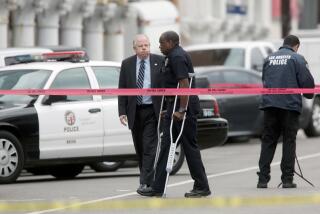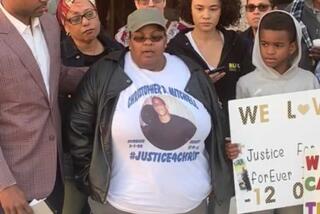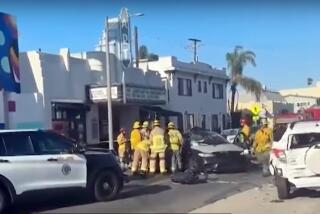Chase Officer: Acosta Tried to Cause Crashes
Acosta ‘looked at me and smiled’ during the pursuit, said Santa Ana Officer William T. Chaney.
One of several police officers who pursued Vincent William Acosta in a high-speed chase that resulted in three deaths in the crash of police helicopters a year ago testified Tuesday that the young man tried several times to divert his pursuers by causing traffic accidents.
The Santa Ana police officer, William T. Chaney, also said that at one point when he was driving almost parallel with Acosta during the chase, “He looked at me and smiled.”
Prosecutors are scheduled to rest their case today at Acosta’s preliminary hearing before Central Municipal Judge James M. Brooks in Santa Ana, where the 20-year-old Anaheim man is charged with three counts of murder.
But Acosta’s attorney, Deputy Public Defender William G. Kelley, says he will put on an active defense--rare for defense attorneys at a preliminary hearing--in an attempt to have the murder charges dismissed before going to trial.
“What happened was a bad thing, but it wasn’t any murder,” Kelley said emphatically after the second day of testimony Tuesday.
Kelley would not say who his witnesses will be, only that he will put on up to 10 witnesses. Kelley said he is taking such unusual steps at the preliminary hearing partly because it is such an unusual case.
“This should not go to trial as a murder case,” Kelley said. “It’s a stolen car case.”
Acosta was arrested in a stolen, gold Nissan on March 10, 1987, after leading police on a chase that began in Santa Ana, wound its way down to Coast Highway in Newport Beach, then back up through Santa Ana to Anaheim along the Costa Mesa Freeway to the Riverside Freeway.
Several police cars stayed behind Acosta on the ground. But during his route toward East Coast Highway, he was also under a spotlight beam from a police helicopter.
The collision of a Costa Mesa helicopter with a Newport Beach helicopter occurred just as Acosta, driving on MacArthur Boulevard, crossed Bonita Canyon Road. Officials say the crash apparently occurred when the Costa Mesa helicopter was passing the pursuit responsibilities to the Newport Beach helicopter.
Killed in the collision were Costa Mesa police officers John William Libolt, 39; James David Ketchum, 39, and a civilian with them, Jeffrey Pollard, 27, from Tustin. Officials in the other helicopter landed safely.
Afterwards, helicopters from Huntington Beach and Anaheim joined in the chase.
Acosta was arrested after he managed to get the car, which had blown a right front tire, off the Riverside Freeway at the Lemon Street exit, just a block from his own home.
Acosta, who is in custody on $250,000 bail, could face up to 45 years in prison if convicted on the three murder counts. Several family members and friends of Acosta attended Tuesday’s hearing.
Deputy Dist. Atty. Thomas J. Borris contends that Acosta is guilty of second-degree murder because a reasonable person in Acosta’s situation should have realized that his actions were so reckless that they could result in someone’s death.
But Acosta’s attorney Kelley disagrees.
“The helicopter crash was the result of pilot negligence,” he said. “No one could know to any reasonable degree that a ground chase could result in the deaths of someone up in the air.”
Kelley called the pilot negligence a “superseding intervention”.
Kelley objected to Officer Chaney’s testimony that Acosta was trying to cause an accident, and Judge Brooks ordered it stricken.
But prosecutor Borris said later that “it’s obvious from the evidence that’s exactly what he (Acosta) was trying to do.”
Chaney said Acosta would pass a car on either the left or the right, then instead of continuing in the open lane, cut back directly in front of the car he passed so that the car’s driver would have to hit his brakes. Chaney also said Acosta several times cut quickly out of an open lane at a high rate of speed to cross three lanes which had heavy traffic, then cut back across again.
Chaney also said that heading north on Coast Highway, Acosta at one point moved into the southbound traffic lanes as oncoming traffic scattered to avoid a collision. Chaney said Acosta made a similar move later when leaving Superior Avenue, with Chaney right behind him.
Waving his arms in a demonstration, Chaney said oncoming traffic was “trying to get out of our way any way they could.”
Kelley also objected to Chaney saying he saw Acosta smile, claiming that the officer was drawing a conclusion about Acosta’s state of mind. Judge Brooks qualified that answer but suggested to Kelley that the officer “is only telling what he saw, he’s not trying to look into the depths of (the defendant’s) soul.”
More to Read
Sign up for Essential California
The most important California stories and recommendations in your inbox every morning.
You may occasionally receive promotional content from the Los Angeles Times.










